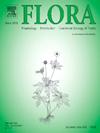热带干旱森林植物木质部结构变化调控盐度下的生理反应
IF 1.7
4区 生物学
Q3 ECOLOGY
引用次数: 0
摘要
植物在非生物胁迫下的死亡与木质部的脆弱性和调节水力机制的能力有关。了解盐水环境中的这些过程可以揭示共存物种未来的生存动态。本研究探讨了Caatinga干旱林不同功能植物类群木质部性状的调节如何影响其在盐碱条件下的适应。对高木材密度(HWD)和低木材密度(LWD)落叶树种进行了分析。在完全随机设计(CRD)下,在苗圃(70%遮阳)中,植物受到不同的电导率:0.15(对照),2.5,3.5和4.5 dS m−1,为期90天。评估了气孔导度(gs)、木质部水势(Ψxylem)、叶、茎、根中Na+/K+比值、叶数、木质部解剖特征、潜在水力导率(Kp)和茎、根木质部易损指数。数据分析采用多项式回归和Tukey检验(P = 5%)。HWD组表现出较高的木质部性状抗性值、较高的gs值(298 mmol m−2 s−1)、最高EC水平下较高的Na+/K+叶降(1.1 ~ 1.9)、气孔密度(31.2%)和叶片更新。随盐度升高,LWD组木质部导管管腔直径(60%)、易损指数(90%)和Kp(80%)均显著降低,Ψxylem升高(约-1 MPa),根内Na+/K+比值升高(约160%)。HWD种表现出抗性,生理稳定,解剖调整轻微,而LWD种对木质部的调节更多,以应对盐度。未来的研究应探讨这些调整在不同环境下的局限性。本文章由计算机程序翻译,如有差异,请以英文原文为准。

Changes in xylem architecture modulate physiological responses in coexisting tropical dry forest plants under salinity
Plant mortality under increasing abiotic stress is associated with xylem vulnerability and the ability to adjust hydraulic mechanisms. Understanding these processes in saline environments can reveal the future survival dynamics of coexisting species. This study investigated how adjustments in the xylem traits of different functional plant groups from the Caatinga dry forest influence adaptation under saline conditions. Deciduous species with high wood density (HWD) and low wood density (LWD) were analyzed. The plants were subjected to different electrical conductivities: 0.15 (control), 2.5, 3.5, and 4.5 dS m−1 for 90 days in a nursery (70 % shading) under a completely randomized design (CRD). The following parameters were evaluated: stomatal conductance (gs), xylem water potential (Ψxylem), Na+/K+ ratio in leaf, stem, and root, leaf number, xylem anatomical characteristics, potential hydraulic conductivity (Kp), and the xylem vulnerability index of the stem and root. Data were analyzed using polynomial regression and Tukey’s test (P = 5 %). The HWD group showed higher xylem trait resistance values, higher gs (298 mmol m−2 s−1), leaf drop with a higher Na+/K+ ratio (1.1–1.9) at the highest level of EC, stomatal density (by 31.2 %), and leaf renewal. The LWD group exhibited a more significant reduction in xylem vessel lumen diameter (60 %), vulnerability index (90 %), and Kp (80 %) with salinity, higher Ψxylem (by ca. -1 MPa), and Na+/K+ ratio in the root (ca. 160 %). HWD species showed resistance, with physiological stability and slight anatomical adjustment, while LWD species adjusted the xylem more to cope with salinity. Future studies should explore the limits of these adjustments in different environments.
求助全文
通过发布文献求助,成功后即可免费获取论文全文。
去求助
来源期刊

Flora
生物-植物科学
CiteScore
3.30
自引率
10.50%
发文量
130
审稿时长
54 days
期刊介绍:
FLORA publishes original contributions and review articles on plant structure (morphology and anatomy), plant distribution (incl. phylogeography) and plant functional ecology (ecophysiology, population ecology and population genetics, organismic interactions, community ecology, ecosystem ecology). Manuscripts (both original and review articles) on a single topic can be compiled in Special Issues, for which suggestions are welcome.
FLORA, the scientific botanical journal with the longest uninterrupted publication sequence (since 1818), considers manuscripts in the above areas which appeal a broad scientific and international readership. Manuscripts focused on floristics and vegetation science will only be considered if they exceed the pure descriptive approach and have relevance for interpreting plant morphology, distribution or ecology. Manuscripts whose content is restricted to purely systematic and nomenclature matters, to geobotanical aspects of only local interest, to pure applications in agri-, horti- or silviculture and pharmacology, and experimental studies dealing exclusively with investigations at the cellular and subcellular level will not be accepted. Manuscripts dealing with comparative and evolutionary aspects of morphology, anatomy and development are welcome.
 求助内容:
求助内容: 应助结果提醒方式:
应助结果提醒方式:


